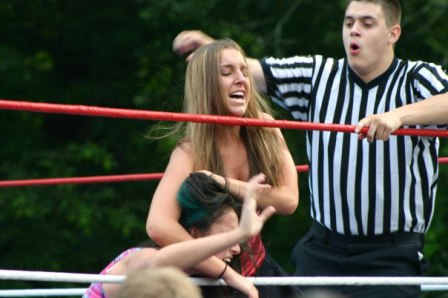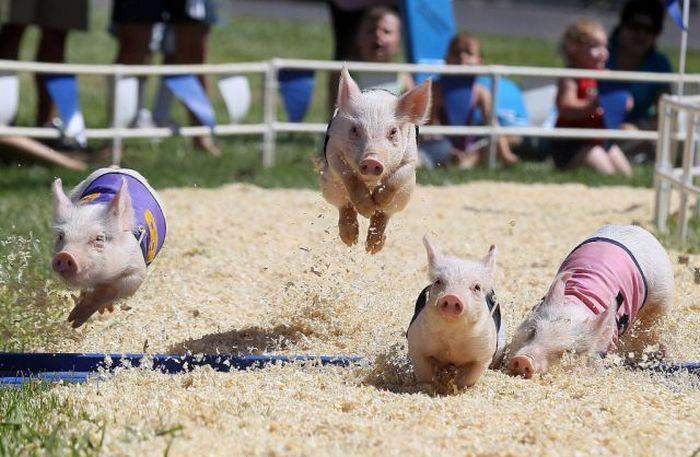Who Remembers…The Whaling City Festival?
Clam cakes at the Whaling City Festival. Photo by BlueSleepy
It used to be that every year you could look forward to an annual city tradition. You could rely on it as sure as day and night would follow one another. There was no thinking about it. You didn’t need to wonder if it was going to happen. Everyone in the greater New Bedford area just knew: every middle of July just head to Buttonwood Park for the Whaling City Festival.
It may seem a bit odd to do a “Who Remembers…?” on such a recent subject like the Whaling City Festival, but it’s fresh in memory and easier to recall. Besides, this series is about reminiscing and the Whaling City Festival had 45 years worth of memories to reminisce about!

Wrestling – along with karate, aikido, Tae Kwon Do demonstrations – was one of the most popular …ahem…attractions.
For just shy of five decades, locals, other New Englanders and even people as far away as Florida would make the trip. Typically 150,000 people would pass through the “gates” over the course of the weekend. Founded in the late 1960s, the festival was originally very small and run by one or two volunteers and a group of local community organizers. That element was always present through the festival’s run and grew to the point where it needed a board of directors and scores of volunteers.
These types of festivals are as American as sliced pie, baseball and Ben Franklin. What’s not to love? A family oriented event where the kids could scream their heads off and they had free license to eat sweets, hot dogs, hamburgers, pizza, cotton candy and all the other things that we parents would usually keep them away from. The kids could be maniacs!
Beyond the amazing aromas that would waft through the grounds from things like the blooming onion, Italian sausages, steak sandwiches, and fried dough, there were amusement rides and games provided by family owned and operated, Fanelli Amusements and Carnival.
Remember the balloon water race? Skeeball, the ring toss, dart balloons, duck pond, free throw Basketball, and other games that you knew you likely weren’t going to win, but played anyway. Kind of like heading to the casino. You go to have fun, but don’t expect a big win. But if you did win the giant stuffed animal, you could carry it around like you were king of the festival. The boss, the chief, the POTWCF.

One of the best parts of the festival was the sheer variety of concession food.
The rides at the Whaling City Festival weren’t like going to Six Flags or Disney World – you wouldn’t find a rotating, spinning, roller coaster going 80mph, but you would find rides that were geared towards younger and smaller kids. Remember the Round Up, Cliff Hanger, Pharaoh’s Fury, Ferris Wheel, Super Slide, or the quintessential festival ride and perennial favorite, the carousel? Dun-Rite was the company that provided a number of popular bubble bounce amusements which are a blast for kids and adults alike.
There was always a karate or Aikido demonstration. There was fun face painting for the kids – what’s a festival or carnival without kids with painted faces running about? The were science shows, petting zoos, a car and bike show, wrestling and for a number of years a laser light show. Of course, there was always a musical line up consisting of many local acts and when possible a famous act that had a golden yesteryear.
Finally, there were many merchants and craft tables. Originally the items offered were high quality, hand-crafted, artisan, or exotic. When city regulations made it more difficult for the organizers to generate revenue, by forcing it to close earlier, for example, it got increasingly more difficult to convince high quality vendors to make the trip from all over the country. A few hours doesn’t seem like much, but it could be the difference between breaking even and making a profit.
This brings up why the festival – and a city tradition – eventually was canceled for good. After a small incident in 2006 – where police were involved- attracted the attention of city officials, a clamp down began. The first punch in the gut came when festival organizers were forced to close earlier. This alone would be the biggest blow to the festival’s profitability and its death knell.

Over 150,000 people will pass through the festival in one weekend.
Sadly, a number of other festivals and events have had violence break out, but no clamp down followed and they were allowed to continue late into the night. In fact, one festival in particular had a shooting incident, yet was allowed to stay open 2 hours later than the Whaling City Festival.
Why the lack of congruence and consistency? I have my own theory on that, but I’ll let you deduce the reason. Shootings at area bars and eateries have never been responded to by forcing them to close earlier – that would be bad for their business. Yet, this concept was ignored when it came to the Whaling City Festival. They were certainly singled out.
With this earlier closing time and fewer vendors interested because of the smaller window to generate revenue, organizers had less money with which to bring musical talent, laser lights, and high quality crafts and merchandise. This contributed to the “Flea Market” feel that characterized the Whaling City Festival in its last years.
Organizers wanted to have a laser light show. They wanted to have famous musical acts. They wanted to have hand crafted goods instead of trinkets. They wanted to carry on a city tradition. However, the earlier hours turned out to have a domino effect on the quality of the event that would eventually kill it.
Between the constricting city clamp down, challenging economic conditions, and a subsequent decrease in corporate sponsorship and volunteers, it was nearly impossible to continue the festival. In 2013, things looked gloomy for the festival and the city began to reconsider allowing the festival to stay open later for the aforementioned reasons.
The problem is that, as with many things, the city is very slow to do things and didn’t approve the later closing time until early April. For a festival of this size, planning for it begins the very next day after it ends. With an approval this late, it left organizers with three months to make the festival happen. Simply not enough time to rally vendors, book musical acts, and garner the necessary volunteers.

The racing piglets was one of many popular attractions.
The festival board of directors reluctantly decided to cancel the 2014 festival altogether. Over the years, I got to personally befriend many of the organizers and volunteers. They were genuinely broken-hearted. They suffered for this decision and considered every option possible to keep it going – even moving it to Fall River.
The last president, Allen Richard never got a chance to demonstrate his passion for the festival and his desire to restore it back to its best years. He had a genuine desire to bring back the laser light shows, improve the quality of the vendors, bring famous musical acts and more. I personally had many private conversations about these things with him. Having grown up as a volunteer for the festival, it was something close to his heart and very personal for him. He really felt like he was letting people down.
A real shame that the Whaling City Festival was canceled. The Lincoln Park closing and the Whaling City Festival cancellation were real bummers. Both were spots responsible for some of our fondest childhood memories. I attended no fewer than 25 of the Whaling City Festival’s events from childhood through adulthood. I had a lot of great, positive memories there.
While we do still have some phenomenal city festivals, there are none that combine the sheer size and atmosphere that the Whaling City Festival provided. It is an annual event that will surely be missed.
ngg_shortcode_0_placeholder
More images of the festival can be found on Flickr: https://www.flickr.com/search/?text=%22whaling%20city%20festival%22